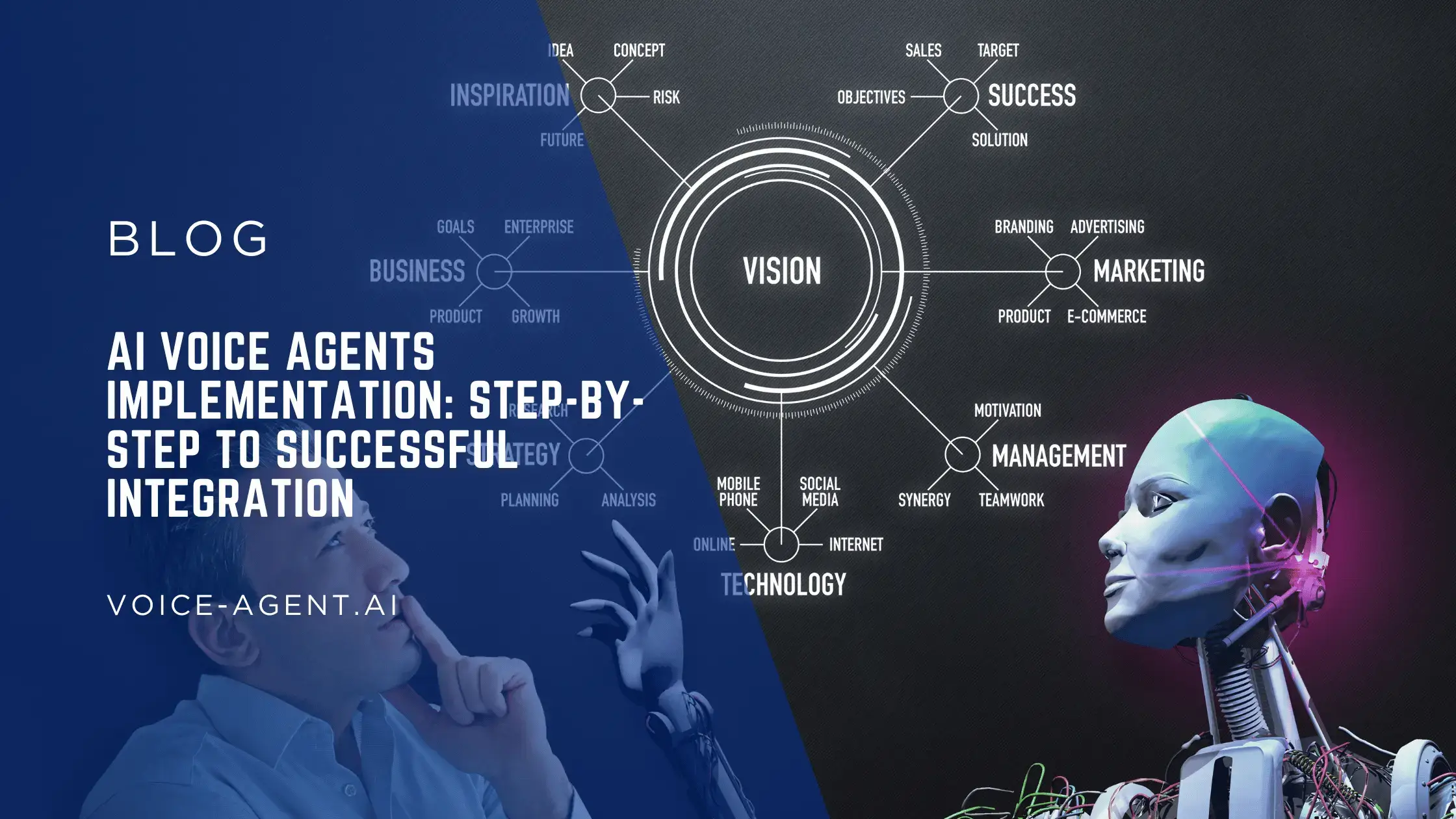Complete Guide to Implementing Voice AI in Your Business
Voice AI technology has matured rapidly, and businesses across industries are discovering its transformative potential. However, successful implementation requires careful planning, strategic thinking, and attention to detail. This comprehensive guide will walk you through every step of the process.
Understanding Voice AI Technology
Before diving into implementation, it's crucial to understand what voice AI can and cannot do:
Core Capabilities
- Speech Recognition: Converting spoken words to text
- Natural Language Understanding: Interpreting intent and context
- Dialogue Management: Managing conversation flow
- Text-to-Speech: Converting responses back to natural-sounding speech
Current Limitations
- Complex emotional nuances
- Highly technical or specialized domains
- Situations requiring human empathy
Phase 1: Assessment and Planning
Business Needs Analysis
Start by identifying specific pain points in your current operations:
Customer Service Bottlenecks
- Average wait times
- Peak hour challenges
- Repetitive query volumes
Cost Analysis
- Current staffing costs
- Training expenses
- Infrastructure maintenance
Customer Experience Gaps
- Satisfaction scores
- Complaint patterns
- Service availability issues
Setting Clear Objectives
Define measurable goals such as:
- Reduce customer wait times by 80%
- Lower operational costs by 50%
- Increase customer satisfaction scores by 25%
- Achieve 99.9% uptime availability
Phase 2: Technology Selection
Key Evaluation Criteria
When choosing a voice AI platform, consider:
1. Technical Capabilities
```markdown
| Feature | Importance | Evaluation Points |
|---|---|---|
| Speech Recognition Accuracy | High | >95% accuracy in your industry |
| Language Support | Medium | Covers your customer base |
| Integration APIs | High | Compatible with existing systems |
| Scalability | High | Handles peak traffic loads |
| ``` |
2. Customization Options
- Industry-specific vocabulary
- Brand voice configuration
- Custom workflow design
- Integration flexibility
3. Analytics and Reporting
- Real-time performance metrics
- Customer interaction insights
- ROI tracking capabilities
- Continuous improvement data
Vendor Evaluation Framework
Create a scoring matrix to objectively evaluate vendors:
```javascript const evaluationCriteria = { technology: { weight: 0.4, factors: ['accuracy', 'reliability', 'speed'] }, support: { weight: 0.3, factors: ['documentation', 'training', 'ongoing_support'] }, cost: { weight: 0.2, factors: ['setup_cost', 'monthly_fees', 'scaling_costs'] }, integration: { weight: 0.1, factors: ['api_quality', 'existing_system_compatibility'] } }; ```
Phase 3: Implementation Strategy
Pilot Program Approach
Start small and scale gradually:
Select a Limited Scope
- Choose one department or service area
- Focus on high-volume, routine interactions
- Set a 3-6 month pilot timeline
Success Metrics
- Customer satisfaction scores
- Cost per interaction
- Resolution rates
- User adoption rates
Technical Implementation Steps
1. Infrastructure Setup
```bash
Example deployment configuration
Voice_AI_Setup:
- Cloud hosting setup
- Security configurations
- Backup systems
- Monitoring tools ```
2. Data Integration
- Customer database connections
- CRM system integration
- Knowledge base linking
- Real-time data synchronization
3. Training Data Preparation
- Collect historical customer interactions
- Create conversation flow templates
- Define escalation procedures
- Prepare FAQ databases
Phase 4: Training and Optimization
AI Training Process
Initial Training Data
- 1000+ conversation examples
- Industry-specific terminology
- Common customer scenarios
- Edge case handling
Iterative Improvement
- Weekly performance reviews
- Conversation quality analysis
- User feedback incorporation
- Continuous model updates
Staff Training Requirements
Even with AI automation, human staff need training on:
- New workflow processes
- Escalation procedures
- AI system monitoring
- Customer handoff protocols
Phase 5: Launch and Monitoring
Soft Launch Strategy
Limited Hours Operation
- Start with business hours only
- Gradual expansion to 24/7
- Monitor performance closely
A/B Testing
- Compare AI vs. human performance
- Test different conversation flows
- Optimize based on results
Key Performance Indicators (KPIs)
Track these metrics for success measurement:
Operational Metrics
- Response Time: Average time to first response
- Resolution Rate: Percentage of issues resolved without escalation
- Availability: System uptime percentage
- Concurrent Handling: Number of simultaneous conversations
Customer Experience Metrics
- Satisfaction Scores: Post-interaction ratings
- Net Promoter Score: Customer loyalty measurement
- Completion Rate: Percentage of successful interactions
- Repeat Contact Rate: Same issue contacted again
Business Metrics
- Cost per Interaction: Total cost divided by interactions
- ROI: Return on investment calculation
- Staff Productivity: Human agent efficiency improvements
- Revenue Impact: Sales/bookings generated
Common Implementation Challenges and Solutions
Challenge 1: Low Initial Accuracy
Solution:
- Invest in comprehensive training data
- Use domain-specific language models
- Implement continuous learning loops
Challenge 2: Customer Resistance
Solution:
- Provide clear opt-out options
- Ensure seamless human escalation
- Communicate benefits transparently
Challenge 3: Integration Difficulties
Solution:
- Conduct thorough technical assessments
- Plan for API development time
- Consider middleware solutions
Challenge 4: Ongoing Maintenance
Solution:
- Establish regular review schedules
- Create feedback collection systems
- Plan for model updates and improvements
Best Practices for Long-term Success
1. Continuous Optimization
- Monthly performance reviews
- Quarterly strategy assessments
- Annual technology evaluations
2. Customer Feedback Integration
- Regular satisfaction surveys
- Analysis of escalated interactions
- User experience testing
3. Staff Development
- Ongoing training programs
- Career path planning for affected roles
- Cross-training opportunities
4. Scalability Planning
- Prepare for traffic growth
- Plan infrastructure scaling
- Consider multi-language expansion
Measuring ROI and Success
ROI Calculation Framework
```javascript const roiCalculation = { costs: { initial_setup: 50000, monthly_subscription: 5000, staff_training: 10000, integration: 15000 }, savings: { staff_reduction: 8000, // monthly efficiency_gains: 3000, // monthly error_reduction: 1000, // monthly overtime_elimination: 2000 // monthly }, // ROI = (Total Savings - Total Costs) / Total Costs * 100 monthly_savings: 14000, annual_savings: 168000, total_first_year_costs: 135000, first_year_roi: 24.4 // percent }; ```
Success Indicators
- Positive ROI within 12 months
- Customer satisfaction improvement
- Operational efficiency gains
- Competitive advantage establishment
Future-Proofing Your Implementation
Emerging Trends to Consider
- Multi-modal AI (voice + text + visual)
- Emotional intelligence capabilities
- Predictive customer service
- Advanced personalization
Technology Evolution Planning
- Regular platform evaluations
- Vendor roadmap alignment
- Emerging technology assessment
- Competitive landscape monitoring
Conclusion
Implementing voice AI in your business is a strategic decision that requires careful planning, execution, and ongoing optimization. By following this comprehensive guide, you'll be well-positioned to successfully deploy voice AI technology that delivers measurable business value while enhancing customer experiences.
Remember that successful implementation is not a one-time event but an ongoing journey of continuous improvement and optimization. Start with clear objectives, choose the right technology partner, and maintain a focus on customer value throughout the process.
Ready to start your voice AI implementation journey? Contact our team for a personalized consultation and implementation roadmap.

